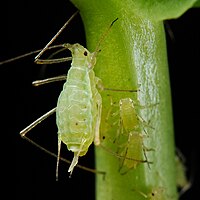
Photo from wikipedia
Diaphorina citri is a vector of "Candidatus Liberibacter asiaticus" (CLas), associated with citrus greening disease. D. citri exhibit at least two color morphotypes, blue and non-blue, the latter including gray… Click to show full abstract
Diaphorina citri is a vector of "Candidatus Liberibacter asiaticus" (CLas), associated with citrus greening disease. D. citri exhibit at least two color morphotypes, blue and non-blue, the latter including gray and yellow morphs. Blue morphs have a greater capacity for long-distance flight and transmit CLas less efficiently as compared to non-blue morphs. Differences in physiology and immunity between color morphs of the insect vector may influence disease epidemiology and biological control strategies. We evaluated the effect of CLas infection on color morph and sex-specific proteomic profiles of D. citri. Immunity-associated proteins were more abundant in blue morphs as compared to non-blue morphs but were upregulated at a higher magnitude in response to CLas infection in non-blue insects. To test for differences in color morph immunity, we measured two phenotypes: (1) survival of D. citri when challenged with the entomopathogenic fungus Beauveria bassiana and (2) microbial load of the surface and internal microbial communities. Non-blue color morphs showed higher mortality at four doses of B. bassinana, but no differences in microbial load were observed. Thus, color morph polyphenism is associated with two distinct proteomic immunity phenotypes in D. citri that may impact transmission of CLas and resistance to B. bassiana under some conditions.